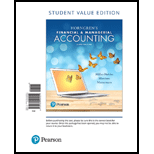
Concept explainers
(1)
Accounts receivable
Accounts receivable refers to the amounts to be received within a short period from customers upon the sale of goods and services on account. In other words, accounts receivable are amounts customers owe to the business. Accounts receivable is an asset of a business.
Bad debt expense:
Bad debt expense is an expense account. The amounts of loss incurred from extending credit to the customers are recorded as bad debt expense. In other words, the estimated uncollectible accounts receivable are known as bad debt expense.
Allowance method:
It is a method for accounting bad debt expense, where uncollectible accounts receivables are estimated and recorded at the end of particular period. Under this method,
To journalize: The bad debt expense using percentage of sales method.
(2)
To show: The way of reporting accounts receivable on the
Want to see the full answer?
Check out a sample textbook solution
Chapter 8 Solutions
Horngren's Financial & Managerial Accounting, Student Value Edition (6th Edition)
- Can you explain this general accounting question using accurate calculation methods?arrow_forwardFinancial Accountingarrow_forwardVista Technologies' year-end 2024 balance sheet shows current assets of $1,200,000, fixed assets of $1,500,000, current liabilities of $800,000, and long- term debt of $1,100,000. What is Vista's total stockholders' equity?arrow_forward
- Pine Ridge Corporation purchased a delivery van for $40,000 on January 1, 2018. The van has an expected salvage value of $2,000 and is expected to be driven 150,000 miles over its estimated useful life of 10 years. Actual miles driven were 18,500 in 2018 and 20,200 in 2019. Calculate the depreciation expense per mile under the units-of-activity method.arrow_forwardPlease provide the answer to this general accounting question with proper steps.arrow_forwardAmazon Industries has a break-even point in sales of $920,000, and its variable expenses are 60% of sales. If the company incurred a loss of $27,600 last year, what must have been the actual sales? a) $851,000 b) $890,000 c) $860,000 d) $750,000arrow_forward

 AccountingAccountingISBN:9781337272094Author:WARREN, Carl S., Reeve, James M., Duchac, Jonathan E.Publisher:Cengage Learning,
AccountingAccountingISBN:9781337272094Author:WARREN, Carl S., Reeve, James M., Duchac, Jonathan E.Publisher:Cengage Learning, Accounting Information SystemsAccountingISBN:9781337619202Author:Hall, James A.Publisher:Cengage Learning,
Accounting Information SystemsAccountingISBN:9781337619202Author:Hall, James A.Publisher:Cengage Learning, Horngren's Cost Accounting: A Managerial Emphasis...AccountingISBN:9780134475585Author:Srikant M. Datar, Madhav V. RajanPublisher:PEARSON
Horngren's Cost Accounting: A Managerial Emphasis...AccountingISBN:9780134475585Author:Srikant M. Datar, Madhav V. RajanPublisher:PEARSON Intermediate AccountingAccountingISBN:9781259722660Author:J. David Spiceland, Mark W. Nelson, Wayne M ThomasPublisher:McGraw-Hill Education
Intermediate AccountingAccountingISBN:9781259722660Author:J. David Spiceland, Mark W. Nelson, Wayne M ThomasPublisher:McGraw-Hill Education Financial and Managerial AccountingAccountingISBN:9781259726705Author:John J Wild, Ken W. Shaw, Barbara Chiappetta Fundamental Accounting PrinciplesPublisher:McGraw-Hill Education
Financial and Managerial AccountingAccountingISBN:9781259726705Author:John J Wild, Ken W. Shaw, Barbara Chiappetta Fundamental Accounting PrinciplesPublisher:McGraw-Hill Education





